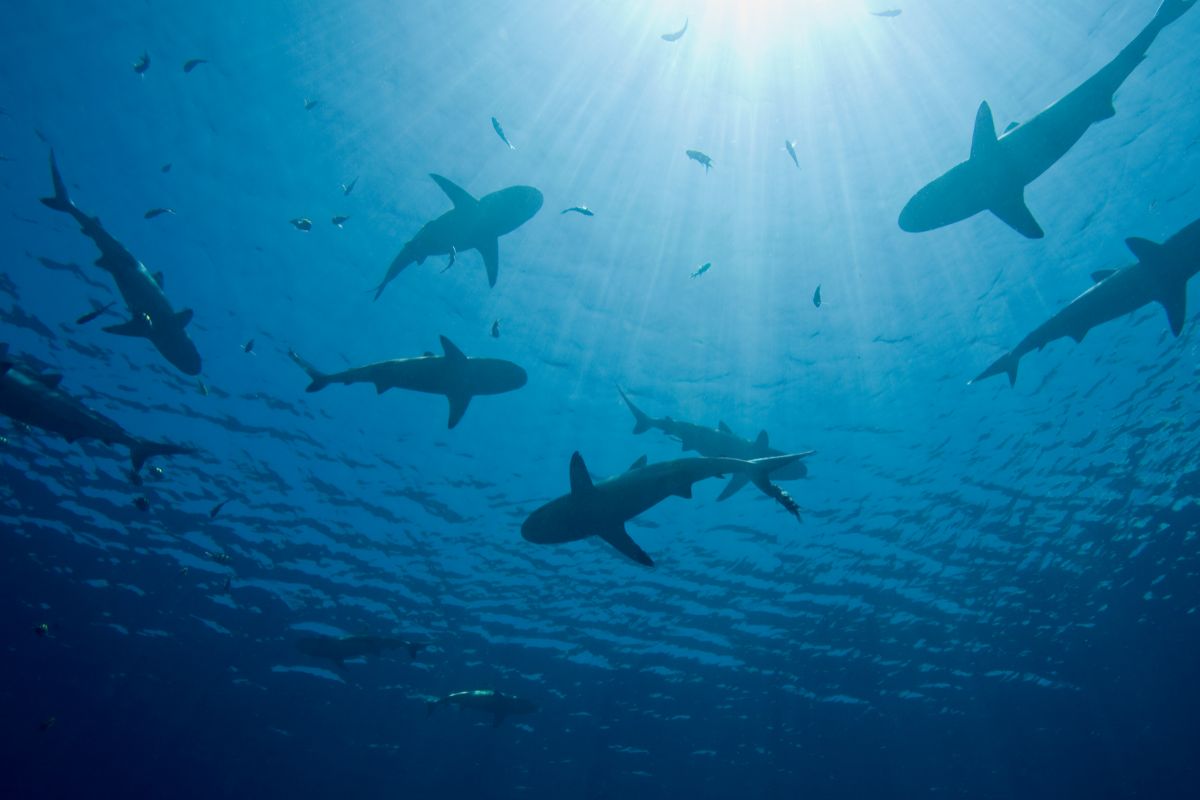All animals need to eat to survive and when that food gets digested the waste needs to go somewhere.
One of the things that all animals have in common is the need to defecate or to put it another way, everything poops!

So yes, sharks poop but how exactly? Well that depends on the shark.
We’ve taken a look at three different types of shark and will share with you what goes in and what comes out of each one.
Shark’s Digestive System
The shark’s digestive system is quite similar to most animals in that it comprises a mouth, esophagus, stomach, digestive tract and rectum.
But there are some important differences in a shark’s digestive system that we are going to look at.
Let’s start with the mouth. Unlike people, sharks do not chew their food but instead rip chunks off their prey and swallow them whole.
Some sharks even swallow their prey completely whole. They don’t have salivary glands in their mouths either.
Once the food gets to the stomach it is digested in a mixture of very strong gastric acids and enzymes. A shark’s stomach can be either U or J shaped.
The digested food which is now in the form of a soup and full of nutrients is passed into the intestines.
In the first part of the intestines, the duodenum, the nutrients are absorbed. As the food passes to the large intestine water is absorbed from the food.
What is left is waste and this moves through to the rectum and is expelled.
One unique thing about sharks is that they have the ability to turn their stomachs inside out like you would with a pocket.
They can then expel the entire contents of their stomach.
This can be a stress response, as they get ready to face a pod of orcas or something similar.
The process is called gastric eversion and is common throughout the shark world.
Great White Shark
The Great White or Carcharodon carcharias is an iconic shark and probably the one that springs to mind when people talk about sharks.
It is an apex predator and faces no real threat in its environment other than from pods of Orcas.
A Great White Shark can often swallow their food whole, which is not that difficult for a fish that can grow to over 20 feet in length.
These sharks are aggressive and curious, and they will bite something just to try and figure out what it is.
The shark’s mouth is one of its sense organs and as they have no hands, this is how they explore the world around them.
It is just unfortunate for the creature or object that they are curious about and bite into.
What Do Great White Sharks Eat?
Great Whites are carnivores and typically eat sea lions, seals, sea turtles, squid, octopus, porpoise, dolphins, and even smaller sharks.
They cruise around the oceans looking for protein-rich food.
Their rows of razor sharp teeth facilitate biting off chunks of meat up to 30lbs in weight at any one time.
A Great White will continue to feed until it’s full, or it may take part in a shark feeding frenzy.
Once it has fed, the acid and enzymes in its stomach will begin to break down the food.
They have large capacity stomachs which are U shaped. Any non-edible parts of its prey such as shell or teeth are vomited back into the ocean.
The food that they do consume makes its way from the stomach to the intestines where nutrients and water are extracted and absorbed.
Whatever is left is waste material and moves through to the rectum to be evacuated.
How Does A Great White Shark Poop?
When the remnants of the Great White’s digestive process reach the lower part of their intestine, the waste is expelled through the cloaca opening.
Underwater this looks like a large cloud which is typically green in color.
A Great White Shark was recently filmed expelling a cloud of feces in a manner never seen before.
The shark is called Lucy, and she is a bit of a celebrity among shark watchers.
Underwater cameras caught sight of Lucy moving up and down in a vertical S movement while pooping.
This is something that has been seen before and is thought to aid the passage of the feces through the system.
The unusual behavior witnessed was a continual mouth gaping action while she was defecating.
In other words, she was opening and closing her mouth while expelling the poop.
A predator-prey ecologist suggested that this was akin to someone grimacing as they push to defecate.
Whale Shark

Whale Sharks, or Rhincodon typus, are the largest known fish species in the ocean with the biggest recorded specimen measuring 61.7 ft.
Incredibly they can achieve a lifespan of between 80-130 years of age.
This shark is a filter feeder rather than a predator like the Great White and is one of only three species of shark that feed this way, the others are the Basking Shark and the wonderfully named Megamouth Shark.
Despite their size Whale Sharks pose no threat to humans and are a very docile fish, quite unlike the Great White.
Younger Whale Sharks will even behave quite playfully around divers in the ocean.
What Do Whale Sharks Eat?
Whale Sharks feed on plankton including krill, copepods, and fish eggs. They also feed on small nektonic life such as small fish and squid.
The filter feeding process can be done in two ways. The Whale Shark can either feed by ram filtration or by active suction feeding.
Ram filtration is when the shark swims forward with its mouth open pushing food into its mouth as it swims.
Active suction feeding involves the shark remaining quite still and sucking large quantities of water into its mouth which is then expelled through the gills.
In both cases the food is trapped by the unique sieve-like structures called filter pads in the shark’s mouth.
Unsurprisingly due to their size, Whale Sharks move quite slowly and cruise the ocean currents scooping up as much food as possible.
They are typically found in tropical oceans and rarely in water less than 70 °F.
How Does A Whale Shark Poop?
A Whale Shark has a digestive system that is typical of sharks in general, although their diet is different to predators such as the Great White or the Tiger Shark.
When a Whale Shark expels waste it will often do a slight wiggle as it poops, again this is thought to be an effort on the shark’s part to facilitate the process.
The waste comes out in the form of a large green cloud, the color is due to the large amount of vegetation they eat.
Scientists study shark waste when they can, to determine things such as the diet and where the sharks tend to feed.
Recently scientists have discovered that Whale Sharks are more vegetarian than previously thought.
Unfortunately, due to the indiscriminate method that Whale Sharks use to feed they are susceptible to ingesting microplastics which have been found in their feces.
Tiger Shark
The Tiger Shark or Galeocerdo cuvier is another apex predator like the Great White Shark and is definitely a carnivore.
It can grow to almost 16 ½ feet and is found in many tropical and temperate waters particularly around central Pacific islands.
It derives its name from the pattern of stripes on its skin which tend to fade as the shark matures. The Tiger Shark is a nocturnal and mostly solitary hunter.
Although it is a predator it can become prey to pods of Orca just like the Great White.
The cryptic coloration of the Tiger Shark coupled with its slow swimming motion can make them quite difficult for predators such as Orcas to spot in some habitats.
This is especially the case against dark backgrounds which helps it to camouflage itself.
What Do Tiger Sharks Eat?
Tiger Sharks are known for their tendency to eat just about anything.
Not only do they consume a regular predator’s diet of fish but will also eat random debris that they happen to come across.
Their ability to turn their stomach inside out, gastric eversion, allows them to digest material with nutrients but dispose of those things that have none.
So although they will eat fish, crustaceans, birds, seals, squid, turtles, sea snakes, dolphins, and smaller sharks they are just as likely to follow that up with a license plate or beer can.
They are also scavengers and have been observed feeding on dead whale carcasses.
The Tiger Shark’s strong, serrated teeth, excellent eyesight and incredible sense of smell make it a fearsome predator.
Dolphins will often avoid territory frequented by Tiger Sharks due to the risk of predation.
How Does A Tiger Shark Poop?
Tiger Sharks have not often been observed defecating in the wild, but it is thought that their feces resembles that of a Great White Shark.
This means that it is likely to be a cloud of green to yellowish-green matter.
Bile and bilirubin from the shark’s stomach and liver, that help to break down the food, mix with the waste matter and produce this color.
The muscle and blood pigments from the Tiger Shark’s food will also influence the color of their feces.
As with other shark feces when it is expelled the Tiger Shark’s waste attracts smaller fish who feed on any remaining particles and nutrients.
This waste material also adds to the nutritional value of the water into which it is expelled and provides for other aquatic plants and organisms most notably, coral.
Final Thoughts
So, we now know that as with other animals sharks need to defecate.
The waste that is produced as a result of their digestive process needs to be expelled from their body.
Whether the shark is a predator or filter feeder the biological processes are much the same and the end result is poop.
We hope that you have found this article about shark poop interesting.
- Is It Possible For A Shark To Swim Backwards? - August 2, 2022
- Are Leopard Sharks Dangerous? - August 2, 2022
- What Are The Differences Between Shark And Dolphin Fins? - August 1, 2022








